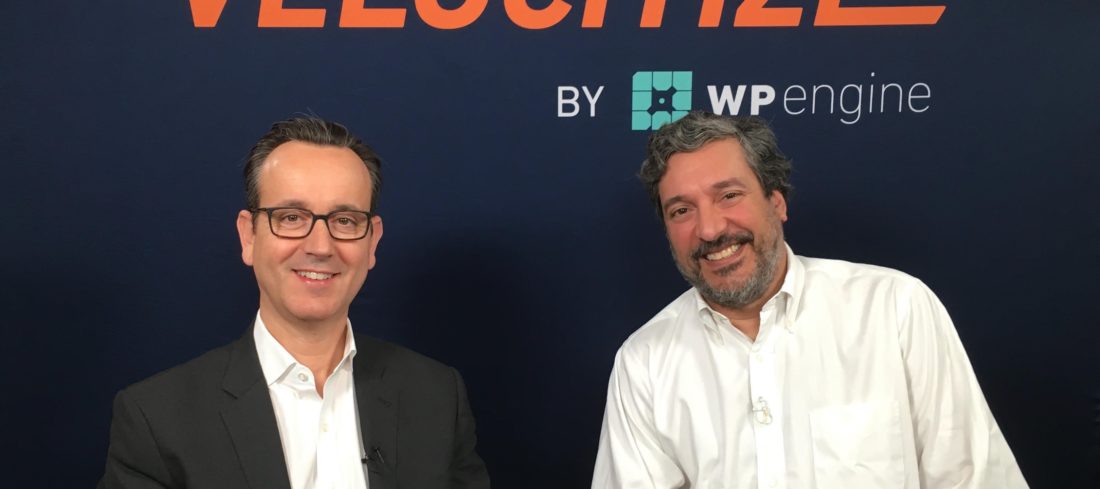When you start to look at who’s excluded, you find ways that you can make your products better and have a much more empathetic view of who your users are and what they’re trying to get done.
Nick Katsivelos is the Director of Digital Advisory Services with Microsoft Design. He is an expert in the areas of computer mediated collaboration and user-centric software design.
At Microsoft, Katsivelos works with clients to develop Digital Transformation Strategies that take advantage of the API Economy. These include cloud computing, personal data ecosystem, digital identity, Software as a Service, and the Internet of Things.
In this episode of Velocitize Talks, Katsivelos shares his insights into the way inclusive design has informed and influenced business.
Access and Inclusive Design (2:22)
The big thing at Microsoft right now is inclusive design. We’re really trying to make sure that things all the way from AI to the way we design experiences and products are inclusive for people.
Making the web and technology accessible for all people, not just some, is happening more due to democratization of technology. Plus it’s really inexpensive to access. Katsivelos points out that high-end technologies like artifical intelligence, for instance, are now within the grasp of anyone who is interested. That’s what’s happening in Microsoft product development as well.
Although AI was initially created in a vacuum, it’s now being used in ways that impact real people. Studying and designing AI from the ground up in an inclusive way means creators are aware of bias—whether it’s positive or negative. That way it can be understood and addressed.
To help create a platform that displays inclusive design in action, Microsoft created a film which presents “a view into how we design for human motivations and needs, expanding interactions to become more inclusive and seeing diversity differently as a dynamic inspiration for creatives.”
Take a Risk (4:37)
In trying to bring change about in large organizations, there are so many factors. What are the rewards systems? How is risk managed in a company? How do you get people to do something that’s unfamiliar and take a risk?
To foster a creative and growth-mindset environment, it is important to be tolerant of mistakes and learn from failures. After all, risky behaviors can produce innovation. There is a way for leaders to encourage risk-taking behaviors while also encouraging “smart risk.”
Katsivelos has worked with many companies to examine how they use technology to innovate. When proposing a different way of thinking or risk, analytical people typically ask for examples where this has worked before. Katsivelos encourages taking chances on something that is new in order to do something unfamiliar—even revolutionary.
Automation Anxiety (6:07)
If you give people a clear education path and show how they can upskill, light bulbs go off. They find opportunity…where they probably hadn’t been looking before.
As technology continues to transform the workplace, people are concerned about what that means for their job in the future. This is especially true when it comes to automation and AI. In fact, The Pew Research Center reports that 72% of Americans are worried about the impact of automation on jobs. It is critical for people to get comfortable with the benefits of automation as well as its impact.
There are benefits to automating routine work, whether that’s cognitive or routine, as it frees up more time for creative. To view technology, AI and automation as enabling and empowering, as opposed to replacing, is important to consider, Katsivelos says. According to the Brookings Institution, the government can offer solutions like wage insurance and financial assistance for lifetime training.
The New CTO (7:47)
No one’s really guiding families on how to manage their IT stack and think about it in a forward-looking way. How do we take this tremendous IT stack that you’ve got at home and in your pocket and use it to set your family up for future success?
Deloitte’s Connectivity and Mobile Trends Survey found that American homes now have an estimated 11 devices competing for internet bandwidth. People have subscribed to an average of 12 media and entertainment services. As a result, these numbers are predicted to grow as the prevalence of the 5G network expands.
As Katsivelos says, there needs to be someone in charge of a household’s technology. This can help families get the most out of their devices. He has started a movement of people who identify themselves as the family CTO (Chief Technology Officer). These CTOs work together to come up with best practices and act as a support network.
The Rise of Voice (10:03)
If you look at e-commerce, where milliseconds matter in conversion rates, voice has challenges too. You don’t want to frustrate your consumers.
Half of all smartphone users are engaging with voice search technology in 2020, according to ComScore. In addition, Google reports that 27% of global online users are using voice search on mobile. While voice can be quite useful for some things, it still has pain points that need refining, like response time.
Katsivelos advocates observing people to see if they’re willing to express themselves verbally, and when they’d rather type or click.
In his research, he has found there are a lot of people who do not want to speak out loud. So when building something, it’s important to address both modes of operation and not choose one or the other. While Katsivelos acknowledges voice is going to keep getting better, he doesn’t consider it the be-all, end-all replacement of other interactive options.
For more information on Microsoft Design, check out their website and follow them on LinkedIn, Facebook and on Twitter at @MicrosoftDesign. To stay up to date with Katsivelos, follow him on LinkedIn.
This interview was originally recorded in 2019 in New York City and has been updated accordingly.
